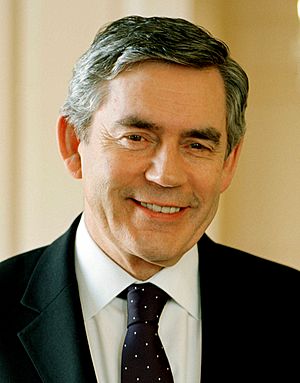Rector of the University of Edinburgh facts for kids

The Rector of The University of Edinburgh is a special person chosen by the students and staff of The University of Edinburgh. They are elected every three years. Most people just call them the Rector, not Lord Rector.
Contents
What Does the Rector Do?
The Rector has an important job at the University of Edinburgh. They lead the University's main governing group, called the University Court. Think of it like being the chairperson of a big meeting where important decisions are made.
The Rector also acts like a helpful guide or a problem-solver for students and staff. If students or staff have worries or ideas, the Rector can listen to them. They make sure these issues are discussed and heard by the University Court. This means the Rector can really help make things better for everyone at the university.
A Look at the Rector's History
The role of Rector was created in 1858. Before that, the city's leaders, like the Lord Provost, ran the university. The job of Rector was made official by a law from the Scottish Parliament in 1889. This law said that all the old universities in Scotland should have a Rector.
Today, only a few of Scotland's oldest universities still elect a Rector. These include St Andrews, Glasgow, Aberdeen, Edinburgh, and the University of Dundee. Newer universities don't have this role.
In 1935, students tried to get a famous Russian revolutionary, Leon Trotsky, to become Rector. But Trotsky said no. He explained that his political views were too strong for a role that was supposed to be non-political.
Usually, people chosen as Rector are well-known figures. They often have a connection to Edinburgh. Gordon Brown was quite unique. He was elected Rector when he was only 21 years old and still a student. Years later, he became the Prime Minister of the United Kingdom!
Who Has Been Rector?
Rectors in the 17th Century
The job of Rector became separate from the Principal's role in 1620.
- 1620 Andrew Ramsay (first time, left in 1626)
- 1627 Sir Alexander Morison
- 1631 No Rector
- 1640 Alexander Henderson
- 1646 Andrew Ramsay (second time, removed in 1648)
- 1649 Robert Douglas
In 1665, the Edinburgh Town Council decided that the Lord Provost of Edinburgh would always be the Rector. The Lord Provost at that time was Andrew Ramsay, who was the son of the earlier Rector, Andrew Ramsay.
Rectors Since 1858
The role of Rector was brought back by a new law in 1858. Here are some of the people who have been Rector since then:
- 1859 William Ewart Gladstone MP
- 1865 Thomas Carlyle
- 1874 Edward Stanley, 15th Earl of Derby
- 1880 Archibald Primrose, 5th Earl of Rosebery
- 1890 George Goschen, 1st Viscount Goschen MP
- 1905 Richard Haldane, 1st Viscount Haldane MP
- 1920 David Lloyd George MP
- 1923 Stanley Baldwin MP
- 1929 Winston Churchill MP
- 1935 Field Marshal Edmund Allenby, 1st Viscount Allenby
- 1948 Alastair Sim
- 1951 Sir Alexander Fleming
- 1960 Jo Grimond MP
- 1972 Gordon Brown
- 1975 Magnus Magnusson
- 1982 David Steel MP
- 1988 Muriel Gray
- 1991 Donnie Munro
- 2000 Robin Harper MSP
- 2003 Sir Tam Dalyell Bt MP
- 2006 Mark Ballard MSP
- 2009 Iain Macwhirter
- 2012 Peter McColl
- 2015 Steve Morrison
- 2018 Ann Henderson
- 2021 Debora Kayembe
- 2024 Simon Fanshawe
See Also
- Ancient university governance in Scotland
- Chancellor of the University of Edinburgh
- Principal of the University of Edinburgh

